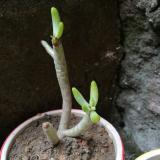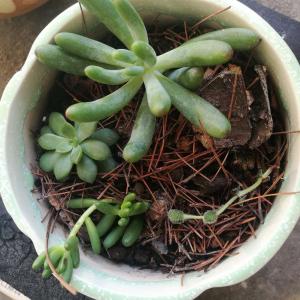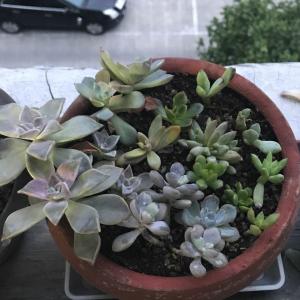文章
Miss Chen
2017年09月22日

La Bowiea volubilis es es una planta suculenta perteneciente a la familia de las Hyacinthceae popularmente, en algunos lugares se la conoce ya como cebolla trepadora. Tiene ramas largas y delgadas, que pueden alcanzar hasta 2 m de longitud, intensamente cubiertas de finas ramitas que a su vez soportan las minúsculas (1 mm) hojas lineales que caen en invierno. Pero sobre todo llama la atención por su bulbo, que puede alcanzar los 25 cm de diámetro, el cual crece con la mitad de color blanco, enterrada y la otra mitad, de tono verdoso en la superficie.
Esta planta es originaria de Sudáfrica y se suele cultivar en maceta. Le buscaremos un lugar muy luminoso donde no reciba sol directo, salvo que vivamos en un lugar muy fresco. No tolera el frío y debe mantenerse por encima de 10 ° C. El suelo debe ser arenoso, compuesto por dos partes de arena y una parte de compost. Usaremos un tutor para guiar las ramas y evitar que la planta se convierta en una masa enmarañada.

Hay que mantener el suelo ligeramente húmedo, pero sin que tenga demasiada agua, la maceta ha de contar con un buen drenaje ya que no tolera nada bien los encharcamientos. Regaremos cada 10 días más o menos y procuraremos no mojar el bulbo para prevenir problemas con los hongos y podredumbres. Durante algunos periodos del año puede perder sus hojas.

La bowiea volubilis se reproduce por semillas o por división del bulbo. Ambas operaciones podemos hacerlas en primavera. Cada dos años aproximadamente cambiaremos la planta de maceta. Es una planta que con facilidad supera los 10 años de vida y con buenos cuidados puede vivir mucho más, hay quien dice que hasta 100 años. Aunque su valor ornamental es escaso se trata de una planta rara y curiosa.
Esta planta es originaria de Sudáfrica y se suele cultivar en maceta. Le buscaremos un lugar muy luminoso donde no reciba sol directo, salvo que vivamos en un lugar muy fresco. No tolera el frío y debe mantenerse por encima de 10 ° C. El suelo debe ser arenoso, compuesto por dos partes de arena y una parte de compost. Usaremos un tutor para guiar las ramas y evitar que la planta se convierta en una masa enmarañada.

Hay que mantener el suelo ligeramente húmedo, pero sin que tenga demasiada agua, la maceta ha de contar con un buen drenaje ya que no tolera nada bien los encharcamientos. Regaremos cada 10 días más o menos y procuraremos no mojar el bulbo para prevenir problemas con los hongos y podredumbres. Durante algunos periodos del año puede perder sus hojas.

La bowiea volubilis se reproduce por semillas o por división del bulbo. Ambas operaciones podemos hacerlas en primavera. Cada dos años aproximadamente cambiaremos la planta de maceta. Es una planta que con facilidad supera los 10 años de vida y con buenos cuidados puede vivir mucho más, hay quien dice que hasta 100 años. Aunque su valor ornamental es escaso se trata de una planta rara y curiosa.
0
0
文章
Miss Chen
2017年09月21日

El trompillo o lechero rojo, Euphorbia cotinifolia, es un arbusto o pequeño árbol que suele alcanzar una altura de entre 2 y 6 metros. En casos excepcionales se ha podido observar algún ejemplar de hasta 19 metros de altura. Se puede usar de diversas formas en jardinería, desde formar setos hasta en solitario.
Si queremos cultivar un trompillo tendremos que buscarle un lugar bien soleado. El suelo debe ser rico en materia orgánica para que se desarrolle bien en sus primeros meses. La coloración rojiza de sus hojas se intensifica con la exposición al sol. Si lo cultivamos a la sombra perderá gran parte de su encanto. El suelo debe estar bien drenado pues es una planta que no tolera nada bien los encharcamientos.

El trompillo es un arbusto oriundo de Sudamérica, crece bien en lugares con clima tropical. No le va bien el frío y menos las heladas, puede desde perder las hojas hasta el ramaje por completo. Se puede reproducir por semillas y por esquejes. Los esquejes es la forma más habitual y para ello hemos de tomarlos de las ramas semileñosas.

Aunque es una planta que se usa tanto en jardinería de espacios públicos como privados hay que tener en cuenta que su savia puede producir reacciones adversas a nivel dermatológico, alergias, irritaciones e incluso quemaduras. Las hojas además contienen diversos principios tóxicos que pueden producir salivación profusa, vómitos e irritaciones del aparato digestivo en caso de ingesta. Vigilaremos pues dónde lo cultivamos si en casa hay niños y mascotas.
Si queremos cultivar un trompillo tendremos que buscarle un lugar bien soleado. El suelo debe ser rico en materia orgánica para que se desarrolle bien en sus primeros meses. La coloración rojiza de sus hojas se intensifica con la exposición al sol. Si lo cultivamos a la sombra perderá gran parte de su encanto. El suelo debe estar bien drenado pues es una planta que no tolera nada bien los encharcamientos.

El trompillo es un arbusto oriundo de Sudamérica, crece bien en lugares con clima tropical. No le va bien el frío y menos las heladas, puede desde perder las hojas hasta el ramaje por completo. Se puede reproducir por semillas y por esquejes. Los esquejes es la forma más habitual y para ello hemos de tomarlos de las ramas semileñosas.

Aunque es una planta que se usa tanto en jardinería de espacios públicos como privados hay que tener en cuenta que su savia puede producir reacciones adversas a nivel dermatológico, alergias, irritaciones e incluso quemaduras. Las hojas además contienen diversos principios tóxicos que pueden producir salivación profusa, vómitos e irritaciones del aparato digestivo en caso de ingesta. Vigilaremos pues dónde lo cultivamos si en casa hay niños y mascotas.
0
0
文章
Dummer. ゛☀
2017年09月21日

Ferocactus, commonly called Barrel Cactus, lives anywhere from 50 to 130 years. It begins with a globular shape when young and eventually becomes more cylindrical, slowly reaching anywhere from 2 to 10 feet tall and 1.5 to 3 feet wide, depending on the species. Native to the American Southwest and Mexico, barrel cactus produces long thorns along its many ribs and bright 3-inch, cup-shaped blossoms in yellow and orange from mid-spring into summer. It grows best in U.S. Department of Agriculture plant hardiness zones 9 through 10.

Growing Conditions
Light: Choose a planting location that receives direct sun during all or most of the day. Because Ferocactus eventually leans into the sun instead of growing precisely upright and because it has extremely sharp thorns, place it where people will not brush into it accidentally.
Soil: Plant your cactus in early spring before new roots begin to form in late June and early July. The roots may appear dry, but that is typical before new growth begins. Dig a hole deep enough for the plant’s roots and amend it as needed to provide fast-draining soil. A good soil mixture includes 10 percent native soil, 45 percent washed sand or pumice and 45 percent compost. Ferocactus thrives in poor and arid soil.
Water the cactus at the time of planting to anchor it into the soil. Water again only if the weather in your area is unseasonably dry and if normal spring or winter rainfall doesn’t occur.

General Care
Water after it is established only during unseasonable drought conditions. Otherwise, rainfall provides the only irrigation necessary. In fact, Ferocactus needs a dormant period with dry soil during the winter.
Drape Ferocactus with burlap or other fabric if a heavy frost is predicted in your area, as it is sensitive and could be damaged by cold temperatures.
Mulch your cactus with decomposed granite or small pebbles for decorative purposes to mimic the plant’s native habitat. Ferocactus is naturally fire-resistance and mulching with stone increases the fire-resistance of your entire landscape.

Tip
Ferocactus thrives with no fertilizer.

Warning
Like all succulents, Ferocactus will die if overwatered.

Growing Conditions
Light: Choose a planting location that receives direct sun during all or most of the day. Because Ferocactus eventually leans into the sun instead of growing precisely upright and because it has extremely sharp thorns, place it where people will not brush into it accidentally.
Soil: Plant your cactus in early spring before new roots begin to form in late June and early July. The roots may appear dry, but that is typical before new growth begins. Dig a hole deep enough for the plant’s roots and amend it as needed to provide fast-draining soil. A good soil mixture includes 10 percent native soil, 45 percent washed sand or pumice and 45 percent compost. Ferocactus thrives in poor and arid soil.
Water the cactus at the time of planting to anchor it into the soil. Water again only if the weather in your area is unseasonably dry and if normal spring or winter rainfall doesn’t occur.

General Care
Water after it is established only during unseasonable drought conditions. Otherwise, rainfall provides the only irrigation necessary. In fact, Ferocactus needs a dormant period with dry soil during the winter.
Drape Ferocactus with burlap or other fabric if a heavy frost is predicted in your area, as it is sensitive and could be damaged by cold temperatures.
Mulch your cactus with decomposed granite or small pebbles for decorative purposes to mimic the plant’s native habitat. Ferocactus is naturally fire-resistance and mulching with stone increases the fire-resistance of your entire landscape.

Tip
Ferocactus thrives with no fertilizer.

Warning
Like all succulents, Ferocactus will die if overwatered.
0
0
文章
Miss Chen
2017年09月20日

La margarita de Singapur, Sphagneticola trilobata, o vedelia es una planta de crecimiento rastrero originaria de la costa brasileña y las islas del Caribe. Aunque sólo levanta unos 30 cm del suelo sus tallos pueden crecer horizontalmente hasta los 2 metros de longitud. Necesita un ambiente húmedo y cálido. Ideal para cultivar en zonas cercanas al mar y que cuenten con clima templado o tropical.
Su follaje verde intenso y sus flores amarillas hacen de esta planta una gran cobertura para espacios soleados o con sombra parcial. Utilizada en macizos y parterres es un gran aliado para hacer destacar aún más a sus compañeras.

Para cultivar la margarita de Singapur necesitamos un lugar soleado y un suelo previamente enriquecido con estiércol. Concretamente necesitaremos un kilogramo de estiércol por metro cuadrado. Regaremos el terreno antes de plantar la vedelia. Así la planta enraizará con rapidez y vigor.

Sacaremos las plantas de las macetas en las que vienen cuando las compramos y las iremos colocando en el suelo. Como su tamaño puede variar bastante es conveniente hacer el hoyo en el suelo individualmente para que se adapte a cada planta en concreto. Para combinar una buena formación foliar y una correcta floración es interesante usar un fertilizante NPK 14-04-08 que cubrirá todas las necesidades nutricionales de nuestra margarita de Singapur.

Los riegos deben ser regulares y abundantes. Se trata de una planta que necesita humedad constante pero nunca que quede agua encharcada. Por lo tanto hay que tener muy en cuenta el drenaje del suelo donde vamos a plantarla. Generalmente la regaremos cada 10 días pero claro está ello dependerá de múltiples factores. Hay que vigilar las enfermedades fúngicas por el tema de la humedad y controlar su crecimiento pues puede convertirse en una planta invasora. Finalmente destacar que es una planta tropical y muy sensible a las heladas.
Su follaje verde intenso y sus flores amarillas hacen de esta planta una gran cobertura para espacios soleados o con sombra parcial. Utilizada en macizos y parterres es un gran aliado para hacer destacar aún más a sus compañeras.

Para cultivar la margarita de Singapur necesitamos un lugar soleado y un suelo previamente enriquecido con estiércol. Concretamente necesitaremos un kilogramo de estiércol por metro cuadrado. Regaremos el terreno antes de plantar la vedelia. Así la planta enraizará con rapidez y vigor.

Sacaremos las plantas de las macetas en las que vienen cuando las compramos y las iremos colocando en el suelo. Como su tamaño puede variar bastante es conveniente hacer el hoyo en el suelo individualmente para que se adapte a cada planta en concreto. Para combinar una buena formación foliar y una correcta floración es interesante usar un fertilizante NPK 14-04-08 que cubrirá todas las necesidades nutricionales de nuestra margarita de Singapur.

Los riegos deben ser regulares y abundantes. Se trata de una planta que necesita humedad constante pero nunca que quede agua encharcada. Por lo tanto hay que tener muy en cuenta el drenaje del suelo donde vamos a plantarla. Generalmente la regaremos cada 10 días pero claro está ello dependerá de múltiples factores. Hay que vigilar las enfermedades fúngicas por el tema de la humedad y controlar su crecimiento pues puede convertirse en una planta invasora. Finalmente destacar que es una planta tropical y muy sensible a las heladas.
0
0
文章
权问薇
2017年09月20日

#芹菜
芹菜可以说是厨房必备,无论凉拌还是清炒,都清爽开胃。想想每天去市场花2块买芹菜,一年就是700,真不便宜啊。作为养花小达人的我们还不如自己种几棵呢~

①做菜前,记得把芹菜头(约4-6cm)切下来,这次不要丢了。

②把这个小菜头稍微冲洗一下,准备一个小碟子或小碗,盛一点水。然后把这个芹菜头立在上面,要是站不稳斜倚着也行。

③弄完后把它端到明亮的窗台边,享受日光浴,隔天换一次水,同时也要给菜头喷喷水。大约在窗边呆5-7天,它边上的茎叶会变得干黄,中间原本嫩黄的叶子变得嫩绿。

④这时候,我们就算大功告成……一半了,然后我们要做的就是把芹菜头转移到花盆里,用盆土盖住外围干黄的部分,把顶端小芽露在外面就可以。
⑤再就是记得2-3天浇透一次水,保持盆土湿润。一周左右就能看到芹菜芽不断往上冒了。

⑥芹菜长得很快,大约3-4周的样子,就会枝繁叶茂了。如果你不嫌弃,就已经可以掐着吃了哦~
小葱
小葱也是必备厨房必备品,如果家里种上一盆,既能观赏,又可以随时拿来做菜,很省事哦~

①买回新鲜的小葱,保留根部,上面的泥土也不用清洗。

②从葱头部分切下,保留根部以上约4-5cm。

③准备好花盆,配土可以是腐叶土加腐熟的饼肥。在把小葱埋进土里,露出顶部1/2,覆盖土壤,轻轻压平。

④放在有阳光的地方,大约2-3天浇水一次。一周后,葱根的位置会长出新芽。这时可以多施有机肥。

⑤大约1-2个月,就可以吃了,注意不要连根拔,直接掐断就可以。这样保证下次还能继续生长,你就可以不断地吃到新鲜的小葱啦~

大蒜
大蒜是做菜时经常用上的作料,没有蒜,做出来的菜可能会寡然无味。我们可以试着在家种一些哦,现在初秋季节更合适。

①准备好健康的蒜瓣,可以撕掉表皮再播种,懒的话就不用撕了,反正都能发芽长大,就是这么好养活。
②准备好花盆,在土壤上喷点水,微湿。将蒜瓣插入土中,芽点朝上。
③大约一周就会抽出小芽。这时候要经常晒太阳,不至于徒长的又细又弱。
④蒜苗长到8-10cm,可以适当的施点有机肥,如果太密需要间苗。

⑤大约1-2个月,就可以采下来吃了。注意不要连根拔起,底部留2cm左右,下次还可以长出2-3茬。另外图中会慢慢长出白白胖胖的大蒜来,可以用来吃或者留着下次播种用哦。

韭菜
说到韭菜,就想起了它一茬一茬割不完,也想起了韭菜鸡蛋、韭菜盒子,韭菜鸡蛋馅饺子……这么好吃又容易种,你的阳台怎么能不来一盆~
①想要种韭菜,首先你得有一包种子。然后用水浸泡12小时左右,再将泡过的种子用湿布包好,放在室内明亮通风的地方就可以,每天用清水浇透布面1-2次。

②大约5-7天,种子会露出小白芽,这时就可以播种了。将土壤浸湿,再把种子浅埋,上面覆盖一层薄薄的细土就好,轻轻压实。
然后也可以在花盆上覆盖一层薄膜(要是没有就算了),放在阴凉通风的地方,1-2周可顺利发芽哦。

③韭菜出苗前,2-3天浇一次水,韭菜出苗后大约每周浇水一次,同时施一点有机肥会长得更旺噢。出苗后可以把韭菜移到光照充足的地方。

④韭菜生长期为3个月左右,当幼苗长到20cm左右时,就可以吃啦。

⑤每次剪完一茬韭菜,可以追施一点氮磷钾肥,以利于韭菜的再次生长,几乎每个月都能收1-2茬噢。

芹菜可以说是厨房必备,无论凉拌还是清炒,都清爽开胃。想想每天去市场花2块买芹菜,一年就是700,真不便宜啊。作为养花小达人的我们还不如自己种几棵呢~

①做菜前,记得把芹菜头(约4-6cm)切下来,这次不要丢了。

②把这个小菜头稍微冲洗一下,准备一个小碟子或小碗,盛一点水。然后把这个芹菜头立在上面,要是站不稳斜倚着也行。

③弄完后把它端到明亮的窗台边,享受日光浴,隔天换一次水,同时也要给菜头喷喷水。大约在窗边呆5-7天,它边上的茎叶会变得干黄,中间原本嫩黄的叶子变得嫩绿。

④这时候,我们就算大功告成……一半了,然后我们要做的就是把芹菜头转移到花盆里,用盆土盖住外围干黄的部分,把顶端小芽露在外面就可以。
⑤再就是记得2-3天浇透一次水,保持盆土湿润。一周左右就能看到芹菜芽不断往上冒了。

⑥芹菜长得很快,大约3-4周的样子,就会枝繁叶茂了。如果你不嫌弃,就已经可以掐着吃了哦~
小葱
小葱也是必备厨房必备品,如果家里种上一盆,既能观赏,又可以随时拿来做菜,很省事哦~

①买回新鲜的小葱,保留根部,上面的泥土也不用清洗。

②从葱头部分切下,保留根部以上约4-5cm。

③准备好花盆,配土可以是腐叶土加腐熟的饼肥。在把小葱埋进土里,露出顶部1/2,覆盖土壤,轻轻压平。

④放在有阳光的地方,大约2-3天浇水一次。一周后,葱根的位置会长出新芽。这时可以多施有机肥。

⑤大约1-2个月,就可以吃了,注意不要连根拔,直接掐断就可以。这样保证下次还能继续生长,你就可以不断地吃到新鲜的小葱啦~

大蒜
大蒜是做菜时经常用上的作料,没有蒜,做出来的菜可能会寡然无味。我们可以试着在家种一些哦,现在初秋季节更合适。

①准备好健康的蒜瓣,可以撕掉表皮再播种,懒的话就不用撕了,反正都能发芽长大,就是这么好养活。
②准备好花盆,在土壤上喷点水,微湿。将蒜瓣插入土中,芽点朝上。
③大约一周就会抽出小芽。这时候要经常晒太阳,不至于徒长的又细又弱。
④蒜苗长到8-10cm,可以适当的施点有机肥,如果太密需要间苗。

⑤大约1-2个月,就可以采下来吃了。注意不要连根拔起,底部留2cm左右,下次还可以长出2-3茬。另外图中会慢慢长出白白胖胖的大蒜来,可以用来吃或者留着下次播种用哦。

韭菜
说到韭菜,就想起了它一茬一茬割不完,也想起了韭菜鸡蛋、韭菜盒子,韭菜鸡蛋馅饺子……这么好吃又容易种,你的阳台怎么能不来一盆~
①想要种韭菜,首先你得有一包种子。然后用水浸泡12小时左右,再将泡过的种子用湿布包好,放在室内明亮通风的地方就可以,每天用清水浇透布面1-2次。

②大约5-7天,种子会露出小白芽,这时就可以播种了。将土壤浸湿,再把种子浅埋,上面覆盖一层薄薄的细土就好,轻轻压实。
然后也可以在花盆上覆盖一层薄膜(要是没有就算了),放在阴凉通风的地方,1-2周可顺利发芽哦。

③韭菜出苗前,2-3天浇一次水,韭菜出苗后大约每周浇水一次,同时施一点有机肥会长得更旺噢。出苗后可以把韭菜移到光照充足的地方。

④韭菜生长期为3个月左右,当幼苗长到20cm左右时,就可以吃啦。

⑤每次剪完一茬韭菜,可以追施一点氮磷钾肥,以利于韭菜的再次生长,几乎每个月都能收1-2茬噢。

3
5
文章
权问薇
2017年09月20日


怎么施肥
1、#迷迭香 不是喜肥的植物,不过还是需要相应的肥料的。迷迭香是不需要太多肥料的。施肥的时候要注意施薄一点的肥料。
2、给迷迭香施肥之后不能立刻离开,要用土把施过肥的地方盖好才行,
3、家养迷迭香施要注意每次收获之后都要立即追肥一次,肥的成分主要是氮磷为好,所施的肥料最好选择见效快的肥料。这样才能事迷迭香二次生长,第二次在花园中收获的才能更好。

肥料选择
选择富含磷和钾的养花肥料更为合适,肥料要根据植株成长的特点挑选,最好溶解快见效快的。肥料不能有毒,不能影响土壤。这样的肥料才能给它们使用。迷迭香对干旱的环境适应还挺强的,幼苗时要注意施肥之前要把土壤里的草铲除干净期,根据情况确定施肥的多少。

注意事项
对这种植物的养护还要稍微有耐心一点,值得注意的是,施肥过量大量小都容易引起问题,相信如果有足够细心的小伙伴,就不会有用不好的肥。既然是这种情况,那大家就快快去种迷迭香吧。

1
1
文章
权问薇
2017年09月20日


#金钱木 的施肥时间与方法:
温度达到20度至30度时,金钱木便可生长,在生长期间,每个月可以施肥2次至3次,肥料可以用磷钾肥与尿素混合使用,或者是硝酸钙;若比较懒的友友们可以每个月给金钱木施一次肥,肥料可以选用专门的液肥,为防治金钱木的叶子变黄,可以在肥料中混合一些硫酸亚铁;
在9月下旬以后,要逐渐减少施肥,同时也要避免施氮肥,可以选用磷钾肥,施2次至3次即可,这对金钱木的越冬有很大的帮助,同时还可以让新发出的嫩叶更加的饱满厚实;

当温度下降到15度以下时,要停止一切施肥工作,低温很容易让其根部遭到肥料的伤害;
若遇到金钱木的开花,不必额外施肥,只要按照正常的施肥程序就可以,因为金钱木的花期最多能维持一天,无论你施不施肥,都是一样的,只要做好正常的养护即可。

金钱木的施肥注意事项:
金钱木的肥料多以肥液为主,为了不造成土壤过于潮湿,影响到金钱木的健康生长,所以在施肥时一定要与浇水相互配合好;
肥水的量一定要掌握好,过足时,极易烂根。

2
0
文章
权问薇
2017年09月20日


#玻璃翠 修剪时间与方法:
幼苗生长时期要进行2次至3次摘心,可以促进侧枝的生长,增加开花的数量,使整体株型更加美观。
如果玻璃翠涨势过高,要把所有过高的枝条全部剪去,减少不必要的养分流失,涨势过高的枝条也是徒长造成的,所以没有必要在让它继续生长。
发现有涨势弱或较小的枝条,也要适当的修剪,保留较为健壮的枝条;整株植物过密时,也可把较小的枝条剪下。

花期内,玻璃翠的下半(靠近土壤)部分若有花开出,则要及时的摘掉,不可让它继续保留,这样可以让上半部分的开花数量逐渐增多,花朵陆续开放。
玻璃翠是种多年生的植物,所以在每次开花后,花朵会慢慢的越来越稀疏,这时就要强行把稀疏的花朵全部剪掉,可能有的友友会非常的不舍得,认为已经稀疏了,为什么还要全部剪掉呢?剪掉后再配合合理的施肥,会让玻璃翠下次的开花更加繁盛。

贴心提示
玻璃翠生长速度比较快,涨势也比较旺盛,所以在修剪时不必担心,可以放心大胆的修剪,就算最后修剪的株型不满意,给它一段时间,它就会恢复过来。
0
0
文章
Miss Chen
2017年09月20日

Adromischus marianae f. alveolatus es una pequeña planta suculenta, perenne, de estructura muy ramificada pero que no alcanza más allá de los 15 cm de altura. Los tallos son gruesos, un poco más estrechos en la base y el ápice. Miden unos 2 cm de longitud y 5 mm de grosor y de ellos parten las hojas horizontales que suelen aparecer de forma simétrica.
Estas hojas son muy gruesas y tienen forma obovada, es decir de huevo invertido, o elípticas. A veces presentan un aspecto verrugoso por la proliferación de tubérculos. Son de color gris verdoso y miden unos 3,5 cm de largo por 2 cm de ancho. Las flores son verdes con un matiz rosáceo y miden 1,2 cm de longitud. Como vemos todas las dimensiones de la planta son muy comedidas ya que no hay que olvidar que la planta en su medio natural suele crecer entre las grietas de suelos graníticos. Es nativa de Little Namaqualand, Provincia del Cabo, Sudáfrica.

Es una planta suculenta de cultivo fácil siempre que usemos un sustrato ligero y suelto que facilite un buen drenaje. El sustrato de cactus nos irá especialmente bien con esta pequeña suculenta. Su reducido tamaño nos permitirá colocarla en cualquier rincón de nuestra casa. Eso sí tendrá que ser en un lugar soleado y cálido.

El riego debe ser regular, sobre todo en primavera y otoño, y dejaremos siempre que el suelo seque bien entre riegos. En invierno, si mantenemos el suelo seco, puede tolerar ligeras heladas, en concreto hasta -7ºC. También hay que fijarse especialmente que las hojas no tengan nada de agua en estas condiciones climáticas.

Las cochinillas y gorgojos de la vid son las plagas más frecuentes que pueden atacar a la Adromischus marianae. Es fácil de propagar por esquejes de hoja. Sólo hay que tomar una de ellas y colocarla sobre un sustrato húmedo. En algunas especies las hojas se sueltan con mayor o menor facilidad, en algún caso es necesario cortar las hojas para usarlas en su propagación.
Estas hojas son muy gruesas y tienen forma obovada, es decir de huevo invertido, o elípticas. A veces presentan un aspecto verrugoso por la proliferación de tubérculos. Son de color gris verdoso y miden unos 3,5 cm de largo por 2 cm de ancho. Las flores son verdes con un matiz rosáceo y miden 1,2 cm de longitud. Como vemos todas las dimensiones de la planta son muy comedidas ya que no hay que olvidar que la planta en su medio natural suele crecer entre las grietas de suelos graníticos. Es nativa de Little Namaqualand, Provincia del Cabo, Sudáfrica.

Es una planta suculenta de cultivo fácil siempre que usemos un sustrato ligero y suelto que facilite un buen drenaje. El sustrato de cactus nos irá especialmente bien con esta pequeña suculenta. Su reducido tamaño nos permitirá colocarla en cualquier rincón de nuestra casa. Eso sí tendrá que ser en un lugar soleado y cálido.

El riego debe ser regular, sobre todo en primavera y otoño, y dejaremos siempre que el suelo seque bien entre riegos. En invierno, si mantenemos el suelo seco, puede tolerar ligeras heladas, en concreto hasta -7ºC. También hay que fijarse especialmente que las hojas no tengan nada de agua en estas condiciones climáticas.

Las cochinillas y gorgojos de la vid son las plagas más frecuentes que pueden atacar a la Adromischus marianae. Es fácil de propagar por esquejes de hoja. Sólo hay que tomar una de ellas y colocarla sobre un sustrato húmedo. En algunas especies las hojas se sueltan con mayor o menor facilidad, en algún caso es necesario cortar las hojas para usarlas en su propagación.
0
0
文章
Dummer. ゛☀
2017年09月20日

The genus Tavaresia includes at least 2 species (Tavaresia barklyi, Tavaresia angolensis) of spiny stem succulents native to southern Africa. Short, erect, 6-14 angled stems carry rows of tubercles furnished with 3 fine white spines which gives the plants a cactoid appearance. Technically, these spines represent a modified leaf spine with 2 side stipules, unique to this genus. Stems take on a dramatic dark colouration in a sunny position, contrasting with the spines. The large funnel-shaped flowers make these plants attractive to collectors. Swellings near the tips of the coronal lobes are also unique to this genus.
Growing Conditions
Light: Tavaresias prefer light shade rather than full sun, although stems may not color up under shady conditions.
Water: They should at all times sparingly watered (best rain water with some occasional fertilizer), and in winter time they hardly require any.
Temperature: A minimum winter temperature of 41°F (5°C) is acceptable, providing that plants are kept absolutely dry.
Soil: They grow well in light gritty soil with a very liberal drainage.
General Care
Tavaresias are mainly grown by plant collectors, lovers of succulents and enthusiasts who enjoy growing unorthodox looking plants. They comes from summer rainfall areas, and are intolerant of excess water, humidity and low winter temperatures and easily destroyed by molds. Flower buds drop off easily in response to the slightest touch or unfavorable conditions.
Propagation
Plants are usually increased by cuttings, which, as they are very succulent, should be allowed to dry a week after they are taken off, when they may at once be put singly into pots. Grafting the Tavaresia on Stapelias is often useful, and can be recommended.
Pest and Problems
Keep their roots free of mealy bugs, as fungal attack often occurs as a result of damage to stems by insects. A layer of grit on the surface of the compost prevents moisture from accumulating around the base of the stems and minimize the chance of fungal attack on the roots.

Growing Conditions
Light: Tavaresias prefer light shade rather than full sun, although stems may not color up under shady conditions.
Water: They should at all times sparingly watered (best rain water with some occasional fertilizer), and in winter time they hardly require any.
Temperature: A minimum winter temperature of 41°F (5°C) is acceptable, providing that plants are kept absolutely dry.
Soil: They grow well in light gritty soil with a very liberal drainage.

General Care
Tavaresias are mainly grown by plant collectors, lovers of succulents and enthusiasts who enjoy growing unorthodox looking plants. They comes from summer rainfall areas, and are intolerant of excess water, humidity and low winter temperatures and easily destroyed by molds. Flower buds drop off easily in response to the slightest touch or unfavorable conditions.

Propagation
Plants are usually increased by cuttings, which, as they are very succulent, should be allowed to dry a week after they are taken off, when they may at once be put singly into pots. Grafting the Tavaresia on Stapelias is often useful, and can be recommended.

Pest and Problems
Keep their roots free of mealy bugs, as fungal attack often occurs as a result of damage to stems by insects. A layer of grit on the surface of the compost prevents moisture from accumulating around the base of the stems and minimize the chance of fungal attack on the roots.
0
0
文章
Dummer. ゛☀
2017年09月19日

Frailea are very small cacti that rarely reach 2 inches (5 cm) in diameter. The plants are native Brazil. These little cacti are quite interesting in their form but their life cycle is even more surprising. There are several species of this genus available for home growers, but the plants are considered threatened in their native habitat.
Rounded, flattish mounds of solitary to occasionally divided chocolate, purple-brown or greenish brown Fraileas make interesting contrasts to other succulents. This genus is named for Manuel Fraile, who once was in charge of the cactus collection of the United States Department of Agriculture.
Growing Fraileas is not difficult and these little plants are super starter plants for the novice gardener or just for someone who travels consistently but wants to come home to a living thing.
The majority of these plants grow as solitary little flattened domes. The spines are extremely tiny and arrayed along the ribs. The body of the plant may range from chocolate to reddish green with several other color variations possible. Often, the plant will produce a fuzzy white fruit that dries to a fragile, membranous capsule filled with large seeds. This fruit is often a surprise as flowers are rare and are cleistogamous, meaning they don’t need to open to produce fruit and seed.
If you are lucky enough to observe a full bloom, the flower will be larger than the body of the plant and rich sulfur yellow. Growing Frailea is easy from seed as germination is quick and reliable.

Rounded, flattish mounds of solitary to occasionally divided chocolate, purple-brown or greenish brown Fraileas make interesting contrasts to other succulents. This genus is named for Manuel Fraile, who once was in charge of the cactus collection of the United States Department of Agriculture.
Growing Fraileas is not difficult and these little plants are super starter plants for the novice gardener or just for someone who travels consistently but wants to come home to a living thing.

The majority of these plants grow as solitary little flattened domes. The spines are extremely tiny and arrayed along the ribs. The body of the plant may range from chocolate to reddish green with several other color variations possible. Often, the plant will produce a fuzzy white fruit that dries to a fragile, membranous capsule filled with large seeds. This fruit is often a surprise as flowers are rare and are cleistogamous, meaning they don’t need to open to produce fruit and seed.

If you are lucky enough to observe a full bloom, the flower will be larger than the body of the plant and rich sulfur yellow. Growing Frailea is easy from seed as germination is quick and reliable.
0
0
文章
Dummer. ゛☀
2017年09月19日

Oak leaf blister (oak leaf curl) is a fungal leaf disease caused by the fungus Taphrina caerulescens. Circular, raised areas ranging up to 2 inches in diameter are scattered over the upper leaf surface. During cool wet springs, almost all species of oak are subject to the leaf blister disease. Members of the red oak family are particularly susceptible to infection. The disease is closely related to Taprina deformans which causes peach leaf curl.
Symptoms and Diagnosis
Blister-like, circular, raised areas appear scattered on the upper leaf surface. This raised area causes a corresponding depression on the lower leaf surface at the same site and of the same size. The color of the upper convex area is yellowish white while the bottom concave area is yellowish brown.
Leaves with numerous spots may fall prematurely to the ground. If well-established trees defoliate before midsummer, they will sometimes leaf out later in the season. When defoliation occurs in late summer, leaf loss will have little impact on the overall health of the tree.
Life Cycle
During mid-spring, microscopic spores are produced in leaf spots. These spores are carried by wind and splashing raindrops onto bud scales and twigs where they remain in a dormant stage until the following early spring. At this time, rain washes the spores onto young leaves where infection takes place. Depending on weather conditions, small circular spots begin to develop in 2 to 4 weeks. Spores produced on these spots will lodge in bud scales and again remain resting until the following spring. Cool wet weather is required for germination on young leaves, and if these conditions continue, severe infection can occur. If weather conditions are not favorable for spore germination shortly after bud break, only minor infection will occur. As the leaves mature, they become more resistant to infection.
Integrated Pest Management Strategies
1. Maintain plant vigor. Keep the tree well watered during drought conditions (approximately 1 inch of water per week) and well-drained during periods of heavy rain. Fertilize according to soil test recommendations. Apply nitrogen every 3 to 5 years for mature shade trees.
2. General health. Oak leaf blister does not seriously affect the overall health of the tree unless the tree is repeatedly defoliated in successive years. Even if this occurs, the second set of leaves should emerge at a time when conditions are not conducive to reinfection of leaves and newly formed bud scales.
3. Fungicides. A single application of a fungicide applied in the spring at the time of bud-swelling is usually adequate. Apply with a power sprayer and coat buds and twigs thoroughly for good control. chlorothalonil (Daconil) is currently registered for use in controlling oak leaf blister. Fungicides will not be effective if applied after bud break. As with the use of all chemicals, carefully read and follow the manufacturer’s directions.

Symptoms and Diagnosis
Blister-like, circular, raised areas appear scattered on the upper leaf surface. This raised area causes a corresponding depression on the lower leaf surface at the same site and of the same size. The color of the upper convex area is yellowish white while the bottom concave area is yellowish brown.
Leaves with numerous spots may fall prematurely to the ground. If well-established trees defoliate before midsummer, they will sometimes leaf out later in the season. When defoliation occurs in late summer, leaf loss will have little impact on the overall health of the tree.

Life Cycle
During mid-spring, microscopic spores are produced in leaf spots. These spores are carried by wind and splashing raindrops onto bud scales and twigs where they remain in a dormant stage until the following early spring. At this time, rain washes the spores onto young leaves where infection takes place. Depending on weather conditions, small circular spots begin to develop in 2 to 4 weeks. Spores produced on these spots will lodge in bud scales and again remain resting until the following spring. Cool wet weather is required for germination on young leaves, and if these conditions continue, severe infection can occur. If weather conditions are not favorable for spore germination shortly after bud break, only minor infection will occur. As the leaves mature, they become more resistant to infection.

Integrated Pest Management Strategies
1. Maintain plant vigor. Keep the tree well watered during drought conditions (approximately 1 inch of water per week) and well-drained during periods of heavy rain. Fertilize according to soil test recommendations. Apply nitrogen every 3 to 5 years for mature shade trees.
2. General health. Oak leaf blister does not seriously affect the overall health of the tree unless the tree is repeatedly defoliated in successive years. Even if this occurs, the second set of leaves should emerge at a time when conditions are not conducive to reinfection of leaves and newly formed bud scales.

3. Fungicides. A single application of a fungicide applied in the spring at the time of bud-swelling is usually adequate. Apply with a power sprayer and coat buds and twigs thoroughly for good control. chlorothalonil (Daconil) is currently registered for use in controlling oak leaf blister. Fungicides will not be effective if applied after bud break. As with the use of all chemicals, carefully read and follow the manufacturer’s directions.
0
0










